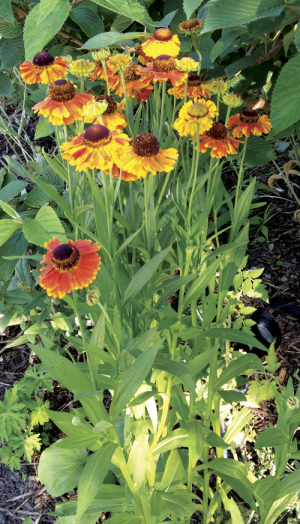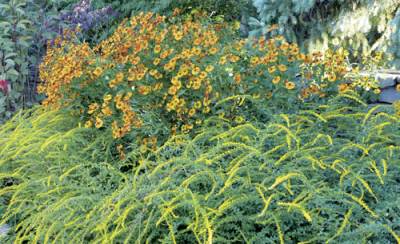April 1, 2014
Nativars: Yea or nay?
BY SEAN JAMES
New dwarf sneezeweeds (Helenium cvs.) are perfect for rain gardens, pollinator support and xeriscapes and fit today’s smaller landscapes well. Factoid: It’s called sneezeweed because it was used to make snuff!
There’s a challenge though; natives are perceived to be less interesting and less showy than some of their foreign cousins. Enter the “nativar,” which is just the new vernacular for a cultivar of a native plant.
The last few years have seen an explosion in nativars. Ninebarks (Physocarpus), switch grass (Panicum), potentilla (don’t you love it when botanical and common names are the same?) and many native tree species now have interesting cultivars in their arsenal. Some are just pretty and others are particularly useful, such as the Green Pillar pin oak (Quercus palustris ‘Pringreen’), which suits our smaller yards. Purple Dome aster is an easy sale, not only for its long-lasting fall colour, but also for its perfect, well-controlled, short form. (Don’t you hate it when they change a simple species name like Aster to something unpronounceable like Symphyotrichon?)
New forms of gardening are appearing as well. Bioretention cells, which clean runoff from impermeable surfaces, need to be pretty for the public to embrace them. Winter Gold sparkleberry (Ilex verticillata ‘Winter Gold’) and dwarf sneezeweeds (Helenium cvs.) are beautiful salesmen for bioretention cells, bringing attention to the issue of stormwater management.
Just to keep us on our toes, a debate arises when we consider whether or not nativars fill the same eco-niche. Much of the reason we want folks planting natives is so our local fauna can feed on them, promoting biodiversity. There’s a good possibility that as we breed our natives to be more consumer-friendly — more beautiful — that local critters won’t recognize them as food. Will the flower fit the bee now that the flowers are bigger? Will the butterfly see the bush as food to lay its eggs on, now that the leaves are purple, or yellow … or plaid? (Why are there no plaid-leafed cultivars? C’mon plant breeders, get on this one.)
Now for those who aren’t engaged in the native/biodiversity/nativar debate, just go on planting the nativars you think are pretty. There’s definitely no harm and it’s better than planting invasives. It will also make landscapes more successful, since the nativars are better adapted to local conditions. “Pretty for pretty’s sake” is okay. There’s a great program called American Beauties that seeks to promote nativars for North American landscapes. It’s even embraced by the World Wildlife Federation. If you keep your eyes peeled, there are many other varieties as well. They just take a little bit more research and some knowledge of what’s native, so you’ll recognize the species. For example, knowing that spotted geranium, Geranium maculatum, is the Ontario native means that you can go hunting for cultivars like ‘Espresso’. Discovering that species of alum root (Heuchera americana and H. villosa) are native, guides us to ‘Stainless Steel’ and ‘Green Spice’. Many gardeners probably didn’t know they were planting natives.
On the other hand, if you're planting for wildlife

The aptly named ‘Fireworks’ Goldenrod isn’t an aggressive spreader, and adds well to the late summer garden. It’s valuable because it tolerates heavy clay and drought and is great for pollinator support, (an issue the public is all too aware of these days.)
This could be seen as a complex issue, or a non-issue, depending on your point of view. Something to add? Feel free to email me at sdjames@on.aibn.com and we can keep the conversation going.
Sean James is owner of an Ontario-based environmentally-conscious landscape design/build/maintenance company. In addition, he is an eco-consultant and a popular speaker.